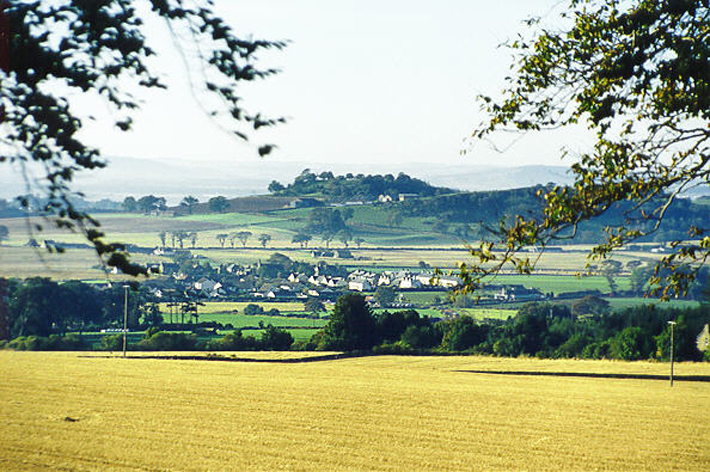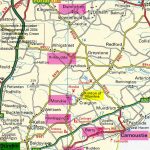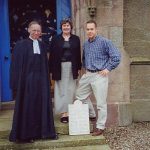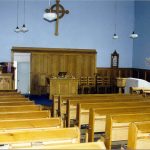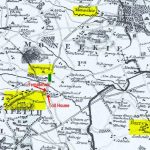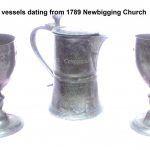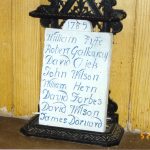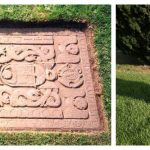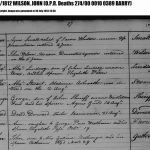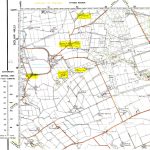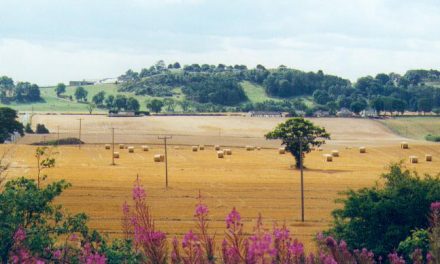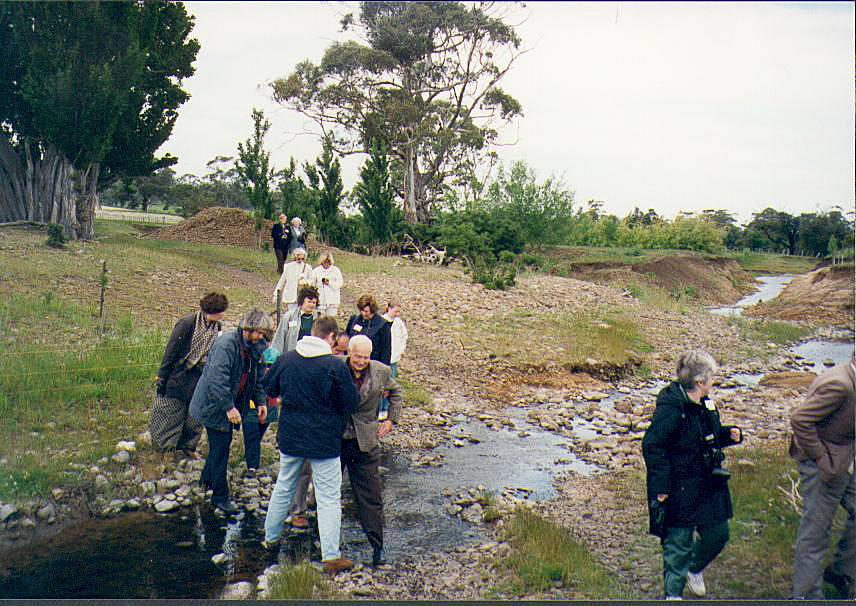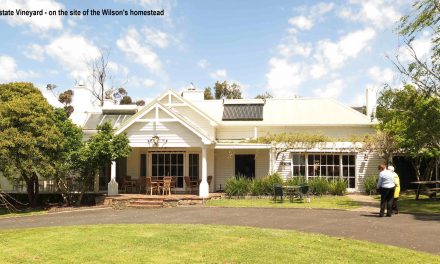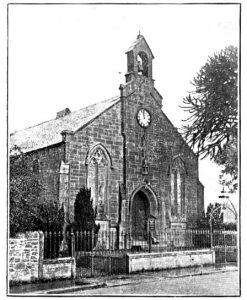
Newbigging Church 1938
Newbigging (an Anglo-Saxon word literally meaning ‘new house/building’) village nestles in the beautiful Scottish lowlands some 30 km north of Dundee, and 10 km west of Monifieth township on the coast. It locates within Monikie Parish just outside of Monifieth Parish boundary. In the feature image above we see the village surrounded by post harvest summer fields, the Drumsturdiemuir strip settlement spanning the mid-distance right to left, Laws (Hill) and farm beyond, and just visible in the far distance the Tay Estuary and County Fife. Our Wilsons from at least mid 18th century lived and worked, and had their families in these places, engaging in farming and stonemason occupations.
Locals talk of the ‘Monikie Mason’: a highly skilled mason who lived and worked there in the latter half of the 18th century, many of his outstanding monuments being located near and in the Monifieth/Monikie Parish areas. We have no evidence that our Wilson mason forebears were he, but we certainly must be considered contenders. Two of the unique designs on headstones in the parishes, which are attributed to the Monikie Mason, are shown in the Gallery below – there are many others.
What we do know is that not only was Bonnie William a skilful mason, but his father, John Wilson also was so talented, and left as his visible legacy in stone the Newbigging Church built in 1788/89, pictured here as it appeared in a sketch created for the celebration of its 150th anniversary in 1938. A more current image photographed about 1998 and ‘tidied up’ by digital removal of traffic signs, lightpoles, dustbins and road markings, is shown below. The late Revd. Douglas Chisholm very kindly undertook research on behalf of our Wilson family in which he established, based on Statistical Records of the Church of Scotland, John Wilson’s leading role in construction of the church building. When completed in 1789 the church had neither bell tower nor clock, and its door and signage we are advised would have been painted grey or brown.
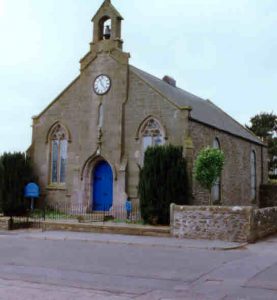
Newbigging Church 1998
Also shown below is an image of a stone tablet which since 1789 sat just inside the front door of the church, which records the names of the parishioners who were involved in its design and construction. Holding the tablet is our cousin Kevin Bowman Wilson – Kevin from the John Bowman Wilson arm of family (Kevin proudly enjoys both the Bowman and Wilson names), during his tour in Scotland in 2004. We note the tablet includes a David Wilson also, but we have not identified whether there is a connection with John. On the reverse side of the stone tablet is the inscription “Sir Alex Ramsay, Knight – the following are the names of those who were the first managers of this meeting – March 28th, 1789″. Sir Alex Ramsay was a wealthy landowner ‘heritor’ – one of those who was a financial patron to the Newbigging Church.
Revd. Chisholm also advised that Newbigging church came about as a secessionist (known as a Non-Conformist ‘Associate Burgher Free Church Congregation’), one of many then forming throughout Scotland in seceding from the official Church of Scotland largely in objection to the practice of Ministers for their congregations being appointed by external non resident parties, such as Royalty, wealthy Heritors, or the central Presbytery of the official church, with no input permitted by the congregation. Many separate ‘sects’ all based on Presbyterian philosophy sprang up each with slightly differing beliefs and practices. Revd. Chisholm informed us that John Wilson and the others named on the plaque were the leaders in this secession in the Newbigging area. Over the next 150 years re-unification of most of these groups was progressively negotiated, so that ultimately Newbigging congregation reunited with the official Church. Most of the former secessionist entities retained the designation Church, whereas the official Church entities were called Kirks in the traditional style.
We note the plaque also has the name David Wilson on it – in Revd. Chisholm’s ‘The Monikie Story’ booklet this David Wilson is stated as living at WilsonHall a farm property which is identified on one of the Gallery of Maps below – it is just a couple of kilometers from Monikie Kirk. We suspect this David Wilson was possibly of the same family as John Wilson, and that the farm property may have been the place where John Wilson’s family resided – but at this time (to 2018) no research has been undertaken to establish this. Could David perhaps be a sibling or even the father of John – future researchers should take this on as a special project. There are sufficient records, many now online, within Scottish repositories covering property ownership, Wills listing ownership and bequeaths, etc, which may allow this question to be answered. (Kirk & Church – the term Kirk was used by the official Church of Scotland whilst Church was used for secessionist congregations)
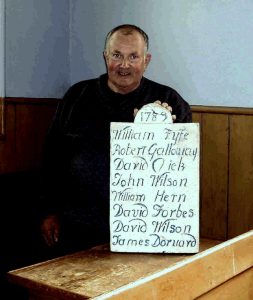
Kevin Wilson displays the Tablet
In 2001 the Dundee Presbytery announced that Newbigging Church was to close due to decline in attendance and its congregation amalgamated with that at Monikie Kirk. Reunion of Secessionist and official Churches had long since been brought about. Fortunately the Tablet and several other church altar implements, communion discs and chalices, dating from the first use of the church are still held at the Monikie Kirk and may be viewed there with prior appointment. Undoubtedly these would have been used by John Wilson, William and all of John’s family of the 18th century [see note below]. The old church finally closed in 2007 – and became a private residence and artists gallery.
John Wilson earned his living as a masonic builder around the Monifieth and Monikie areas – there are a number of buildings which have an inscription on the lintel above their entry doors, a common practice then by masons as a commemorative of their work: some of these we can be certain commemorating John’s work and we might assume that young William Hartley (and perhaps his brothers) worked and learned the trade with their father on these jobs.
At the foot of this page is a gallery of enlargable images, the first of which displays the general region of particular relevance to our Wilson family, showing all of the key places which feature in our story. The Romans established a temporary military camp just a few hours march north of Newbigging at a location called Kirkbuddo, dated to the third century AD – today there are but a few hidden traces at that place. Together with several other Roman camps in the general region it was occupied for only a short number of years, the Romans eventually withdrawing due to hostility of the Celtic tribes and difficulty in maintaining supply lines so far north.
Then a memorable image of our cousin Karen Roe and her son Stuart meeting the Minister Rev. Gordon McKenzie after a service which they attended at the church in 2000. The third image shows the interior of the church which we are advised by local historians is basically as it was when built in 1789, only the furniture having been replaced periodically and other general minor renovations. A manse is located at the rear of the church. Deconsecrated in 2007, and later sold, it’s seen as in 2024 here. Now named ‘Auld Kirk’, perhaps an artistically acceptable title, but historically it was called a church not a kirk.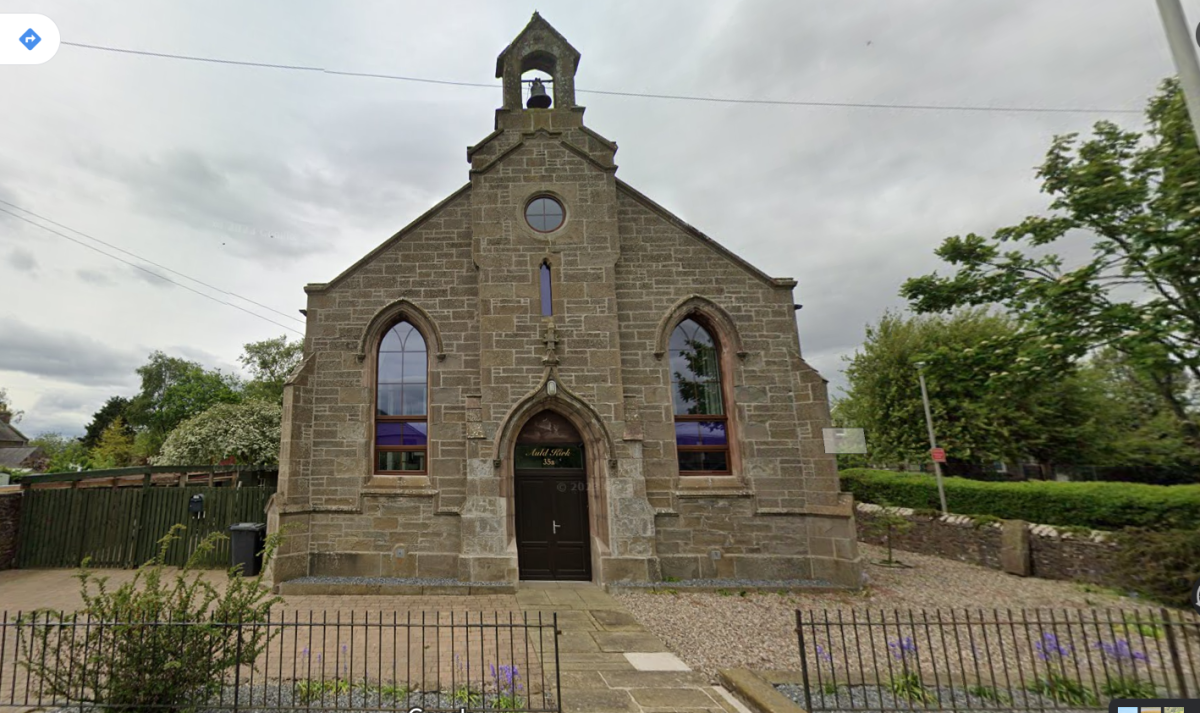
An early (Ainslie, 1788) map below shows us that Newbigging was originally no more than an isolated Estate called Newbigging House (large farms all tended to be designated as House). No village exists at this time (the green block shows where the village later, by early 1800s, evolved). A communal Meeting House is shown close by the later village: Templehall where our Wilson family lived late 18th century, and across the road (then the so called Arbroath Pike) the Toll House exist. Prior to moving to Templehall, in the period from at least 1770 to 1788 our Wilsons lived along the Drumsturdymuir strip of residences which existed on either side of the Pike – thus, the birth records of Bonnie William and his five siblings are recorded as either Drumsturdy, or Laws.
In the Ainslie map image (Ainslie’s mapping was the equivalent of today’s official Government Survey Maps describing every feature and building on the topography in detail) – the small black boxes are homes, and we may be certain one or more of these was the home of the Wilsons at that time. Bonnie William was six years of age when Ainslie surveyed this location in 1788, and it is reasonable to imagine young William and all the young folk of the location were spectators observing the mapping process.
Also on Ainslie’s map is Barry Village and the farmlands around it – this is where Margaret Williamson was resident, and where William’s mother Margaret Bowman and at least two of her children (Matilda and George) are buried, and where two children from the Margaret Ferrier union are buried – John Wilson is also buried there this was confirmed in 2013 – see the record below. The old Barry Church and cemetery location (there are only remnant ruins of the church today) is highlighted in yellow. Readers may also note a fine dotted line just to the left of the Toll running towards the north and also passing by the Newbigging property to the line’s right – this is the border between the parishes of Monifieth and Monikie.
- Regional Locations Map
- Karen & Stuart with Rev. McKenzie Newbigging Church Interior
- Newbigging Church Interior
- Ainslie Map 1788
- Newbigging Church 1789 Tablet
More information about Laws is presented on a further page in our Stories section.
- Monikie Mason Headstones
- John-Wilson-death record -1812
- Wilson Hall in Monikie Parish
Note re the Chalice Set – The Council of Monikie Kirk in 2019 most graciously granted the Chalice Set in perpetual loan to the Scots Church in Hobart Tasmania, Australia and the Set is now on permanent display in the church’s museum. The museum is in fact the original Hobart Scots Church built in 1824 by stonemason/architect, our very own William Hartley Wilson.

